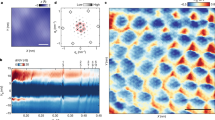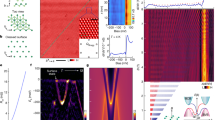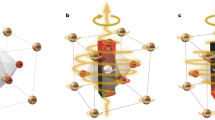Abstract
Polarons are quasiparticles that emerge from the interaction of fermionic particles with bosonic fields1. In crystalline solids, polarons form when electrons and holes become dressed by lattice vibrations. While experimental signatures of polarons in bulk three-dimensional materials abound4,5,6,7,8,9,10,11,12,13,14, only rarely have polarons been observed in two-dimensional atomic crystals. Here, we shed light on this asymmetry by developing a quantitative ab initio theory of polarons in atomically thin crystals. Using this conceptual framework, we determine the real-space structure of the recently observed hole polaron in hexagonal boron nitride, discover a critical condition for the existence of polarons in two-dimensional crystals and establish the key materials descriptors and the universal laws that underpin polaron physics in two dimensions.
This is a preview of subscription content, access via your institution
Access options
Access Nature and 54 other Nature Portfolio journals
Get Nature+, our best-value online-access subscription
$29.99 / 30 days
cancel any time
Subscribe to this journal
Receive 12 print issues and online access
$209.00 per year
only $17.42 per issue
Buy this article
- Purchase on Springer Link
- Instant access to full article PDF
Prices may be subject to local taxes which are calculated during checkout



Similar content being viewed by others
Data availability
The datasets generated during and analysed during the current study are available in the Zenodo repository at https://doi.org/10.5281/zenodo.7496896. Source data are provided with this paper.
Code availability
References
Franchini, C., Reticcioli, M., Setvin, M. & Diebold, U. Polarons in materials. Nat. Rev. Mater. 6, 560 (2021).
Emin, D. Polarons (Cambridge Univ. Press, 2012).
Alexandrov, A. S. & Devreese, J. T. Advances in Polaron Physics Springer Series in Solid-State Sciences (Springer, 2012).
Riley, J. M. et al. Crossover from lattice to plasmonic polarons of a spin-polarised electron gas in ferromagnetic EuO. Nat. Commun. 9, 20 (2018).
Wang, Z. et al. Tailoring the nature and strength of electron–phonon interactions in the SrTiO3(001) 2D electron liquid. Nat. Mater. 15, 835 (2016).
Chen, C., Avila, J., Frantzeskakis, E., Levy, A. & Asensio, M. C. Observation of a two-dimensional liquid of Fröhlich polarons at the bare SrTiO3 surface. Nat. Commun. 6, 8585 (2015).
Cancellieri, C. et al. Polaronic metal state at the LaAlO3/SrTiO3 interface. Nat. Commun. 7, 10386 (2016).
Pastor, E. et al. In situ observation of picosecond polaron self-localisation in α-Fe2O3 photoelectrochemical cells. Nat. Commun. 10, 3962 (2019).
Moser, S. et al. Tunable polaronic conduction in anatase TiO2. Phys. Rev. Lett. 110, 196403 (2013).
Baldini, E. et al. Discovery of the soft electronic modes of the trimeron order in magnetite. Nat. Phys. 16, 541 (2020).
Miyata, K. & Zhu, X.-Y. Ferroelectric large polarons. Nat. Mater. 17, 379 (2018).
Guzelturk, B. et al. Visualization of dynamic polaronic strain fields in hybrid lead halide perovskites. Nat. Mater. 20, 618 (2021).
Miyata, K. et al. Large polarons in lead halide perovskites. Sci. Adv. 3, e1701217 (2017).
Wu, B. et al. Strong self-trapping by deformation potential limits photovoltaic performance in bismuth double perovskite. Sci. Adv. 7, eabd3160 (2021).
Novoselov, K. S. et al. Two-dimensional atomic crystals. Proc. Natl Acad. Sci. USA 102, 10451 (2005).
Novoselov, K. S., Mishchenko, A., Carvalho, A. & Castro Neto, A. H. 2D materials and van der Waals heterostructures. Science 353, aac9439 (2016).
Chen, C. et al. Emergence of interfacial polarons from electron-phonon coupling in graphene/h-BN van der Waals heterostructures. Nano Lett. 18, 1082 (2018).
Kang, M. et al. Holstein polaron in a valley-degenerate two-dimensional semiconductor. Nat. Mater. 17, 676 (2018).
Sio, W. H., Verdi, C., Poncé, S. & Giustino, F. Polarons from first principles, without supercells. Phys. Rev. Lett. 122, 246403 (2019).
Sio, W. H., Verdi, C., Poncé, S. & Giustino, F. Ab initio theory of polarons: formalism and applications. Phys. Rev. B. 99, 235139 (2019).
Sio, W. H. & Giustino, F. Unified ab initio description of Fröhlich electron-phonon interactions in two-dimensional and three-dimensional materials. Phys. Rev. B. 105, 115414 (2022).
Giustino, F. Electron-phonon interactions from first principles. Rev. Mod. Phys. 89, 015003 (2017).
Giannozzi, P. et al. Advanced capabilities for materials modelling with quantum ESPRESSO. J. Phys. Condens. Matter 29, 465901 (2017).
Mostofi, A. A. et al. An updated version of wannier90: a tool for obtaining maximally-localised Wannier functions. Comput. Phys. Commun. 185, 2309 (2014).
Poncé, S., Margine, E. R., Verdi, C. & Giustino, F. EPW: electron–phonon coupling, transport and superconducting properties using maximally localized Wannier functions. Comput. Phys. Commun. 209, 116 (2016).
Wickramaratne, D., Weston, L. & Van de Walle, C. G. Monolayer to bulk properties of hexagonal boron nitride. J. Phys. Chem. C 122, 25524 (2018).
Arnaud, B., Lebégue, S., Rabiller, P. & Alouani, M. Huge excitonic effects in layered hexagonal boron nitride. Phys. Rev. Lett. 96, 026402 (2006).
Wirtz, L. et al. Comment on “Huge excitonic effects in layered hexagonal boron nitride”. Phys. Rev. Lett. 100, 189701 (2008).
Galvani, T. et al. Excitons in boron nitride single layer. Phys. Rev. B. 94, 125303 (2016).
Zhang, F. et al. Intervalley excitonic hybridization, optical selection rules, and imperfect circular dichroism in monolayer h-BN. Phys. Rev. Lett. 128, 047402 (2022).
Gil, B., Cassabois, G., Cusco, R., Fugallo, G. & Artus, L. Boron nitride for excitonics, nano photonics, and quantum technologies. Nanophotonics 9, 3483 (2020).
Li, Z., Antonius, G., Wu, M., da Jornada, F. H. & Louie, S. G. Electron-phonon coupling from ab initio linear-response theory within the GW method: correlation-enhanced interactions and superconductivity in Ba1−xKxBiO3. Phys. Rev. Lett. 122, 186402 (2019).
Dai, S. et al. Tunable phonon polaritons in atomically thin van der Waals crystals of boron nitride. Science 343, 1125 (2014).
Tran, T. T., Bray, K., Ford, M. J., Toth, M. & Aharonovich, I. Quantum emission from hexagonal boron nitride monolayers. Nat. Nanotechnol. 11, 37 (2016).
Cassabois, G., Valvin, P. & Gil, B. Hexagonal boron nitride is an indirect bandgap semiconductor. Nat. Photonics 10, 262 (2016).
Elias, C. et al. Direct band-gap crossover in epitaxial monolayer boron nitride. Nat. Commun. 10, 2639 (2019).
Ugeda, M. M. et al. Giant bandgap renormalization and excitonic effects in a monolayer transition metal dichalcogenide semiconductor. Nat. Mater. 13, 1091 (2014).
Olsen, T., Latini, S., Rasmussen, F. & Thygesen, K. S. Simple screened hydrogen model of excitons in two-dimensional materials. Phys. Rev. Lett. 116, 056401 (2016).
Paleari, F. et al. Excitons in few-layer hexagonal boron nitride: Davydov splitting and surface localization. 2D Mater. 5, 045017 (2018).
Román, R. J. P. et al. Band gap measurements of monolayer h-BN and insights into carbon-related point defects. 2D Mater. 8, 044001 (2021).
Hahn, T., Klimin, S., Tempere, J., Devreese, J. T. & Franchini, C. Diagrammatic Monte Carlo study of Fröhlich polaron dispersion in two and three dimensions. Phys. Rev. B. 97, 134305 (2018).
Peeters, F. M., Xiaoguang, W. & Devreese, J. T. Ground-state energy of a polaron in n dimensions. Phys. Rev. B. 33, 3926 (1986).
Ercelebi, A. & Süalp, G. A variational treatment of a two-dimensional polaron. J. Phys. Chem. Solids 48, 739 (1987).
Jalabert, R. & Das Sarma, S. Quasiparticle properties of a coupled two-dimensional electron-phonon system. Phys. Rev. B. 40, 9723 (1989).
Titantah, J. T., Pierleoni, C. & Ciuchi, S. Free energy of the Fröhlich polaron in two and three dimensions. Phys. Rev. Lett. 87, 206406 (2001).
Kaasbjerg, K., Thygesen, K. S. & Jacobsen, K. W. Phonon-limited mobility in n-type single-layer MoS2 from first principles. Phys. Rev. B. 85, 115317 (2012).
Sohier, T., Calandra, M. & Mauri, F. Two-dimensional Fröhlich interaction in transition-metal dichalcogenide monolayers: theoretical modeling and first-principles calculations. Phys. Rev. B. 94, 085415 (2016).
Deng, T. et al. Ab initio dipolar electron-phonon interactions in two-dimensional materials. Phys. Rev. B 103, 075410 (2021).
Landau, L. D. Electron motion in crystal lattices. Phys. Z. Sowjet. 3, 664 (1933).
Pekar, S. Local quantum states of electrons in an ideal ion crystal. Zh. Eksp. Teor. Fiz. 16, 341 (1946).
Devreese, J. T. Fröhlich polarons. lecture course including detailed theoretical derivations. Preprint at arXiv https://arxiv.org/abs/1012.4576 (2020).
Devreese, J. T. & Alexandrov, A. S. Fröhlich polaron and bipolaron: recent developments. Rep. Prog. Phys. 72, 066501 (2009).
Spanier, J. & Oldham, K. B. An Atlas of Functions (Taylor & Francis/Hemisphere, 1987).
Rytova, N. S. Screened potential of a point charge in a thin film. Proc. MSU, Phys. Astron. 3, 30 (1967).
Keldysh, L. V. Coulomb interaction in thin semiconductor and semimetal films. JETP Lett. 29, 658 (1979).
Cudazzo, P., Tokatly, I. V. & Rubio, A. Dielectric screening in two-dimensional insulators: implications for excitonic and impurity states in graphane. Phys. Rev. B. 84, 085406 (2011).
Feynman, R. P. Slow electrons in a polar crystal. Phys. Rev. 97, 660 (1955).
Prokof’ev, N. V. & Svistunov, B. V. Polaron problem by diagrammatic quantum Monte Carlo. Phys. Rev. Lett. 81, 2514 (1998).
Hahn, T., Klimin, S., Tempere, J., Devreese, J. T. & Franchini, C. Diagrammatic Monte Carlo study of Fröhlich polaron dispersion in two and three dimensions. Phys. Rev. B. 97, 134305 (2018).
Nair, R. R. et al. Fluorographene: a two-dimensional counterpart of Teflon. Small 6, 2877 (2010).
Chang, S.-J. et al. van der Waals epitaxy of 2D h-ALN on TMDS by atomic layer deposition at 250 °C. Appl. Phys. Lett. 120, 162102 (2022).
Al Balushi, Z. Y. et al. Two-dimensional gallium nitride realized via graphene encapsulation. Nat. Mater. 15, 1166 (2016).
Zhang, H. et al. Epitaxial growth of two-dimensional insulator monolayer honeycomb BeO. ACS Nano 15, 2497 (2021).
Wang, H. et al. Improved thermoelectric performance of monolayer HfS2 by strain engineering. ACS Omega 6, 29820 (2021).
Lv, H. Y., Lu, W. J., Shao, D. F., Lu, H. Y. & Sun, Y. P. Strain-induced enhancement in the thermoelectric performance of a ZrS2 monolayer. J. Mater. Chem. C. 4, 4538 (2016).
Li, W., Poncé, S. & Giustino, F. Dimensional crossover in the carrier mobility of two-dimensional semiconductors: the case of InSe. Nano Lett. 19, 1774 (2019).
Ferreira, F., Chaves, A. J., Peres, N. M. R. & Ribeiro, R. M. Excitons in hexagonal boron nitride single-layer: a new platform for polaritonics in the ultraviolet. J. Opt. Soc. Am. B. 36, 674 (2019).
Zhang, W., Huang, Z., Zhang, W. & Li, Y. Two-dimensional semiconductors with possible high room temperature mobility. Nano Res. 7, 1731 (2014).
Laturia, A., Van de Put, M. L. & Vandenberghe, W. G. Dielectric properties of hexagonal boron nitride and transition metal dichalcogenides: from monolayer to bulk. NPJ 2D Mater. Appl. 2, 6 (2018).
Pike, N. A., Dewandre, A., Van Troeye, B., Gonze, X. & Verstraete, M. J. Vibrational and dielectric properties of the bulk transition metal dichalcogenides. Phys. Rev. Mater. 2, 063608 (2018).
Li, W. & Giustino, F. Many-body renormalization of the electron effective mass of InSe. Phys. Rev. B. 101, 035201 (2020).
Garcia-Goiricelaya, P., Lafuente-Bartolome, J., Gurtubay, I. G. & Eiguren, A. Long-living carriers in a strong electron-phonon interacting two-dimensional doped semiconductor. Commun. Phys. 2, 81 (2019).
Yan, C. et al. 2D group IVB transition metal dichalcogenides. Adv. Funct. Mater. 28, 1803305 (2018).
Alexandrov, A. & Ranninger, J. Bipolaronic superconductivity. Phys. Rev. B. 24, 1164 (1981).
Mounet, N. et al. Two-dimensional materials from high-throughput computational exfoliation of experimentally known compounds. Nat. Nanotechnol. 13, 246 (2018).
Rasmussen, F. A. & Thygesen, K. S. Computational 2D materials database: electronic structure of transition-metal dichalcogenides and oxides. J. Phys. Chem. C. 119, 13169 (2015).
Sohier, T., Gibertini, M., Calandra, M., Mauri, F. & Marzari, N. Breakdown of optical phonons’ splitting in two-dimensional materials. Nano Lett. 17, 3758 (2017).
Acknowledgements
This research is primarily supported by the Computational Materials Sciences Program funded by the US Department of Energy, Office of Science, Basic Energy Sciences, under award no. DE-SC0020129 (software development, theoretical model, ab initio calculations). This research used resources of the National Energy Research Scientific Computing Center, a DOE Office of Science User Facility supported by the Office of Science of the US Department of Energy under contract no. DE-AC02-05CH11231. We also acknowledge the Texas Advanced Computing Center at The University of Texas at Austin for providing additional high-performance computing resources, including the Frontera and Lonestar6 systems, that have contributed to the research results reported within this paper (http://www.tacc.utexas.edu). In the final stage, W.H.S. was supported by the Science and Technology Development Fund of Macau SAR under grant no. 0102/2019/A2 (ab initio calculations and data analysis). W.H.S. also acknowledges the Information and Communication Technology Office at the University of Macau and the LvLiang Cloud Computing Center of China for providing extra high-performance computing resources, including the High-Performance Computing Cluster and TianHe-2 systems.
Author information
Authors and Affiliations
Contributions
W.H.S. performed the calculations and data analysis. F.G. conceived and supervised the project. W.H.S. and F.G. developed the theoretical model and wrote the paper.
Corresponding author
Ethics declarations
Competing interests
The authors declare no competing interests.
Peer review
Peer review information
Nature Physics thanks Karsten Jacobsen and the other, anonymous, reviewer(s) for their contribution to the peer review of this work.
Additional information
Publisher’s note Springer Nature remains neutral with regard to jurisdictional claims in published maps and institutional affiliations.
Supplementary information
Supplementary Information
Computational Methods, Notes 1–7, Tables 1–3, Figs. 1–12 and Refs.
Supplementary Data 1
Calculated polaron formation energies for Supplementary Fig. 1.
Supplementary Data 2
Calculated polaron formation energies for Supplementary Fig. 2.
Supplementary Data 3
Calculated polaron formation energies for Supplementary Fig. 3.
Supplementary Data 4
Calculated polaron formation energies for Supplementary Fig. 4.
Supplementary Data 5
Calculated polaron charge density for Supplementary Fig. 5.
Supplementary Data 6
Calculated atomic displacements for Supplementary Fig. 6.
Supplementary Data 7
Calculated polaron charge density for Supplementary Fig. 7.
Supplementary Data 8
Calculated potential function for Supplementary Fig. 8.
Supplementary Data 9
Calculated polaron charge density and polaron weights for Supplementary Fig. 9.
Supplementary Data 10
Calculated polaron charge density and polaron weights for Supplementary Fig. 10.
Supplementary Data 11
Calculated polaron weights for Supplementary Fig. 11.
Supplementary Data 12
Calculated polaron charge density and polaron weights for Supplementary Fig. 12.
Source data
Source Data Fig. 1
Source data for Fig. 1.
Source Data Fig. 2
Source data for Fig. 2.
Source Data Fig. 3
Source data for Fig. 3.
Rights and permissions
Springer Nature or its licensor (e.g. a society or other partner) holds exclusive rights to this article under a publishing agreement with the author(s) or other rightsholder(s); author self-archiving of the accepted manuscript version of this article is solely governed by the terms of such publishing agreement and applicable law.
About this article
Cite this article
Sio, W.H., Giustino, F. Polarons in two-dimensional atomic crystals. Nat. Phys. 19, 629–636 (2023). https://doi.org/10.1038/s41567-023-01953-4
Received:
Accepted:
Published:
Issue Date:
DOI: https://doi.org/10.1038/s41567-023-01953-4
This article is cited by
-
Spin-orbital Jahn-Teller bipolarons
Nature Communications (2024)
-
Solution-phase sample-averaged single-particle spectroscopy of quantum emitters with femtosecond resolution
Nature Materials (2024)
-
Electron–phonon physics from first principles using the EPW code
npj Computational Materials (2023)



